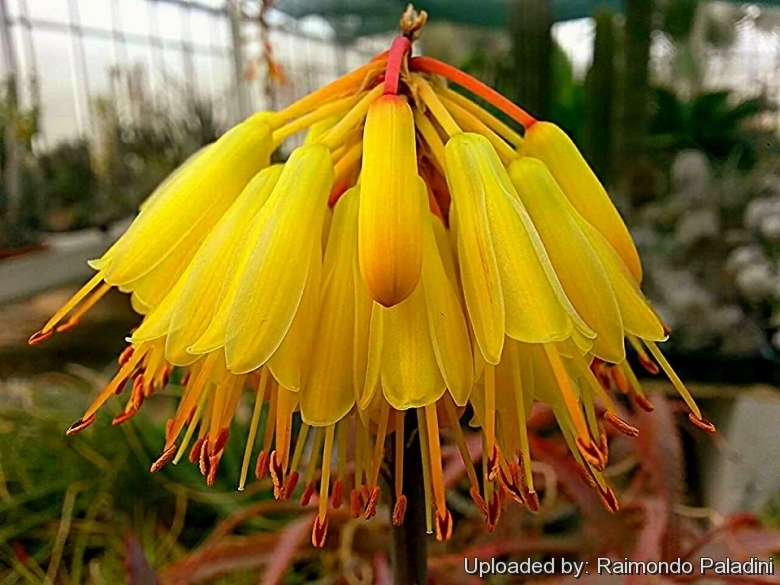Accepted Scientific Name: Aloe cipolinicola (H.Perrier) J.-B.Castillon & J.-P.Castillon
Aloe Madagascar 28. 2010 [Jul 2010] J.-B.Castillon & J.-P.Castillon

Aloe capitata var. cipolinicola (Aloe cipolinicola) Photo by: Raimondo Paladini
Origin and Habitat: Aloe cipolinicolaSN|33911]]SN|33911]] is endemic to Central Madagascar (Basin of Sahatany: Ambatofangehana, to the West of Ambositra, and also 37 km West of Ambatofinandrahana, near the Itremo Village roadfork, and on other hills nearby. Plants also occur 14 km. East of Ambatofinandrahana.)
Altitude range: 1250 - 1400 metres above sea level.
Habitat and ecology: This species grows exclusively on marble outcrops (Cipolin limestones) in the 'pachycaul' grassland of the southern plateaux about Ambatofinandrahana. This plant seems to be fire-resistant. It is widespread in habitat and not threatened by collection.
Synonyms:
Description: Aloe cipolinicola is the only arborescent species in central Madagascar distinguished by a robust solitary stem up to 3 metres tall. The inflorescence is about 1 meter long and consists of six to ten branches. The pedicels are almost missing.
Note: A. cipolinicola is strictly related and once considered a variety of Aloe capitata, but now it is recognised as a distinct species; both them have dense, rounded, capitate racemes but A. capitata and all its varieties have short or apparently absent stems (they never form a distinct trunk).
Derivation of specific name: “cipolinicola” For the occurrence on Cipolin limestones in Madagascar, from Latin ‘-cola’ (inhabiting).
Stem: Simple, erect, 2-3 metres tall, 20 cm in diameter with old dried leaf remains persistent.
Leaves: 60-100, densely rosulate, 30-60 cm long 5-6.5 cm wide regularly narrowed from base to apex, broad at base, glossy green, sometimes tinged reddish unicoloured, mostly flat and not channelled; lower surface rounded, glossy green, margins mostly with reddish horny edge armed with 3 - 4 mm long teeth. Teeth triangular, stiff, reddish 3-4mm long, 10 mm apart at the middle, smaller and more crowded low down, larger and more distant upwards. Tip rounded or somewhat pointed with 2-3 small teeth.
Inflorescence: The inflorescence is a branched panicle about 1 m tall. Peduncle robust, 4-5cm broad near base and 2-5 cm thick with 6 - 10 branches from the middle. Head with a fusiform rachis (5 cm long, 2cm wide). Lower pedicels extremely reduced, shorter than the bracts. Bracts obtuse, oval, 6 mm long, 4mm wide. The lowest flowers open first.
Chromosome number: 2n = 14.
Bibliography: Major references and further lectures
1) Werner Rauh, Herman Schwartz “Succulent and xerophytic plants of Madagascar”, Volume 2 Strawberry Press, 1998
2) Raewyn Adams “Aloes A to Z” Lulu.com, 2015
3) Urs Eggli, Leonard E. Newton “Etymological Dictionary of Succulent Plant Names”. Springer, Berlin/Heidelberg 2010
4) Urs Eggli “Illustrated Handbook of Succulent Plants: Monocotyledons” Springer Science & Business Media, 06 December 2012
5) Gilbert Westacott Reynolds “The Aloes of Tropical Africa and Madagascar” Aloes Book Fund, 1966
6) “Natural Resources Research”, Volume 20 Unesco, 1983
7) Hermann Jacobsen “A Handbook of Succulent Plants: Descriptions, Synonyms, and Cultural Details for Succulents Other Than Cactaceae”, Volume 1Blandford Press, 1960
8) CONVENTION ON INTERNATIONAL TRADE IN ENDANGERED SPECIES OF WILD FAUNA AND FLORA “Eighteenth meeting of the Plants Committee Buenos Aires (Argentina), 17-21 March 2009 - REVIEW OF SIGNIFICANT TRADE IN SPECIMENS OF APPENDIX-II SPECIES” [PC18 Doc. 8.2, PC18 Doc. 8.4, PC18 Doc. 8.5 (Rev. 1)] web: https://cites.org/sites/default/files/eng/com/pc/18/wg/E-PC18-WG03.pdf
9) H. Perrier “Les Lomatophyllum et les Aloë de Madagascar” In: Mémoires de la Société Linnéenne de Normandie. Botanique. 1(1): 37-39, 1926.
10) Estrela Figueiredo and Gideon F. Smith “What’s in a name: epithets in Aloe L. (Asphodelaceae) and what to call the next new species” Bradleya 28/2010pages 79–102
11) Jean-Bernard Castillon “The Aloe of Madagascar” 2010
Cultivation and Propagation: In cultivation Aloe cipolinicolaSN|33911]]SN|33911]] is best suited to warm temperate climates in USDA Zones 9 and 10.










